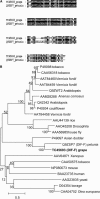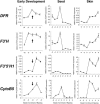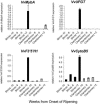Identification of the flavonoid hydroxylases from grapevine and their regulation during fruit development
- PMID: 16377741
- PMCID: PMC1326050
- DOI: 10.1104/pp.105.073262
Identification of the flavonoid hydroxylases from grapevine and their regulation during fruit development
Abstract
Flavonoids are important secondary metabolites in many fruits, and their hydroxylation pattern determines their color, stability, and antioxidant capacity. Hydroxylation of the B-ring of flavonoids is catalyzed by flavonoid 3'-hydroxylase (F3'H) and flavonoid 3',5'-hydroxylase (F3'5'H), and may also require cytochrome b5. We report the identification of genes encoding F3'H, F3'5'H, and a putative cytochrome b5 from grapevine (Vitis vinifera L. cv Shiraz) and their transcriptional regulation in fruit. Functionality of the genes VvF3'H and VvF3'5'H1 was demonstrated by ectopic expression in petunia (Petunia hybrida), which altered flower color and flavonoid composition as expected. VvF3'H was expressed in grapes before flowering, when 3'-hydroxylated flavonols are made, and all three genes were expressed after flowering, when proanthocyanidins (PAs) are synthesized. In berry skin, expression of all three genes was low at the onset of ripening (véraison) but increased after véraison concomitant with the accumulation of 3'- and 3',5'-hydroxylated anthocyanins. VvF3'H and VvCytoB5 were expressed in seeds but not VvF3'5'H1, consistent with the accumulation of 3'-hydroxylated PAs in this tissue. VvCytoB5 expression was correlated with expression of both VvF3'H and VvF3'5'H1 in the different grape tissues. In contrast to red grapes, where VvF3'H, VvF3'5'H1, and VvCytoB5 were highly expressed during ripening, the expression of VvF3'5'H1 and VvCytoB5 in white grapes during ripening was extremely low, suggesting a difference in transcriptional regulation. Our results show that temporal and tissue-specific expression of VvF3'H, VvF3'5'H1, and VvCytoB5 in grapes is coordinated with the accumulation of the respective hydroxylated flavonols and PAs, as well as anthocyanins. Understanding the regulation of flavonoid hydroxylases could be used to modify flavonoid composition of fruits.
Figures







References
-
- Barahona R, Lascano CE, Narvaez N, Owen E, Morris P, Theodorou MK (2003) In vitro degradability of mature and immature leaves of tropical forage legumes differing in condensed tannin and non-starch polysaccharide content and composition. J Sci Food Agric 83: 1256–1266
-
- Boss PK, Davies C, Robinson SP (1996. a) Expression of anthocyanin biosynthesis pathway genes in red and white grapes. Plant Mol Biol 32: 565–569 - PubMed
Publication types
MeSH terms
Substances
Associated data
- Actions
- Actions
- Actions
- Actions
LinkOut - more resources
Full Text Sources
Other Literature Sources
Miscellaneous

